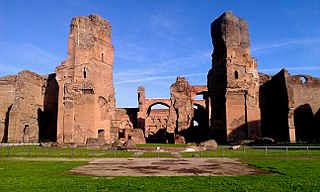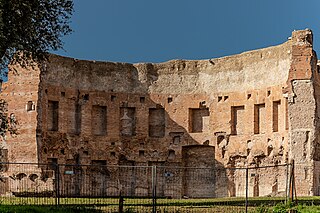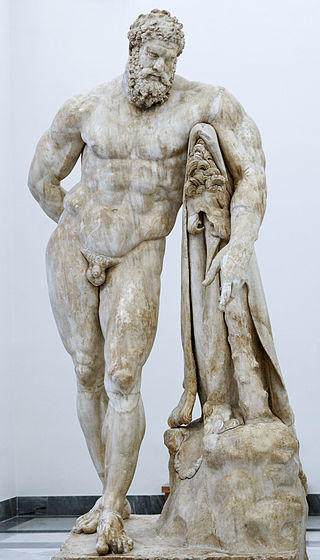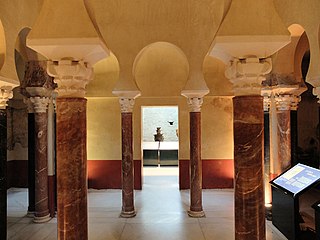
In ancient Rome, thermae and balneae were facilities for bathing. Thermae usually refers to the large imperial bath complexes, while balneae were smaller-scale facilities, public or private, that existed in great numbers throughout Rome.

The Baths of Caracalla in Rome, Italy, were the city's second largest Roman public baths, or thermae, after the Baths of Diocletian. The baths were likely built between AD 212 and 216/217, during the reigns of emperors Septimius Severus and Caracalla. They were in operation until the 530s and then fell into disuse and ruin.

The Gallo-Roman town of Lutetia was the predecessor of the modern-day city of Paris. It was founded in about the middle of the 3rd century BCE by the Parisii, a Gallic tribe. Traces of an earlier Neolithic settlement have also been found at the former site of the city. Lutetia was an important crossing point of the Seine, and was located at the intersection of land and water trade routes. In the 1st century BCE, it was conquered by Romans and was gradually rebuilt into a Roman city. Ruins including a forum, amphitheater, and Roman baths still remain. In the 5th century it became the capital of the Merovingian dynasty of French kings, and thereafter was known simply as Paris.

The Farnese Hercules is an ancient statue of Hercules, probably an enlarged copy made in the early third century AD and signed by Glykon, who is otherwise unknown; the name is Greek but he may have worked in Rome. Like many other Ancient Roman sculptures it is a copy or version of a much older Greek original that was well known, in this case a bronze by Lysippos that would have been made in the fourth century BC. This original survived for over 1500 years until it was melted down by Crusaders in 1205 during the Sack of Constantinople. The enlarged copy was made for the Baths of Caracalla in Rome, where the statue was recovered in 1546, and is now in the Museo Archeologico Nazionale in Naples. The heroically-scaled Hercules is one of the most famous sculptures of antiquity, and has fixed the image of the mythic hero in the European imagination.

The Baths of Diocletian were public baths in ancient Rome. Named after emperor Diocletian and built from 298 CE to 306 CE, they were the largest of the imperial baths. The project was originally commissioned by Maximian upon his return to Rome in the autumn of 298 and was continued after his and Diocletian's abdication under Constantius, father of Constantine.

The Farnese Bull, formerly in the Farnese collection in Rome, is a massive Roman elaborated copy of a Hellenistic sculpture. It is the largest single sculpture yet recovered from antiquity. Along with the rest of the Farnese antiquities, it has been since 1826 in the collection of the Museo Archeologico Nazionale Napoli in Naples, inv. no. 6002, though in recent years sometimes displayed at the Museo di Capodimonte across the city. The sculpture in Naples is much restored, and includes around the base a child, a dog, and other animals not apparently in the original composition, which is known from versions in other media.

The Baths of Titus or Thermae Titi were public baths (Thermae) built in 81 AD at Rome, by Roman emperor Titus. The baths sat at the base of the Esquiline Hill, an area of parkland and luxury estates which had been taken over by Nero for his Golden House or Domus Aurea. Titus' baths were built in haste, possibly by converting an existing or partly built bathing complex belonging to the reviled Domus Aurea. They were not particularly extensive, and the much larger Baths of Trajan were built immediately adjacent to them at the start of the next century.

The National Archaeological Museum of Naples is an important Italian archaeological museum, particularly for ancient Roman remains. Its collection includes works from Greek, Roman and Renaissance times, and especially Roman artifacts from the nearby Pompeii, Stabiae and Herculaneum sites. From 1816 to 1861, it was known as Real Museo Borbonico.

The Baths of Trajan were a massive thermae, a bathing and leisure complex, built in ancient Rome and dedicated under Trajan during the kalendae of July 109, shortly after the Aqua Traiana was dedicated.

The Baths of Agrippa was a structure of ancient Rome, in what is now Italy, built by Marcus Vipsanius Agrippa. It was the first of the great thermae constructed in the city, and also the first public bath.

Bathing played a major part in ancient Roman culture and society. It was one of the most common daily activities and was practiced across a wide variety of social classes. Though many contemporary cultures see bathing as a very private activity conducted in the home, bathing in Rome was a communal activity. While the extremely wealthy could afford bathing facilities in their homes, private baths were very uncommon, and most people bathed in the communal baths (thermae). In some ways, these resembled modern-day destination spas as there were facilities for a variety of activities from exercising to sunbathing to swimming and massage.

Baths of Constantine was a public bathing complex built on Rome's Quirinal Hill, beside the Tiber River, by Constantine I, probably before 315.

The Suburban Baths are a building in Pompeii, Italy, a town in the Italian region of Campania that was buried by the eruption of Mount Vesuvius in 79 AD, which consequently preserved it.

The Welwyn Roman Baths are a Roman ruin preserved under the A1(M) just north of modern-day Welwyn Garden City, Hertfordshire, England. The baths were a small part of the Dicket Mead villa, which was originally built in the 3rd century AD.

The Roman Baths of Ankara are the ruined remains of an ancient Roman bath complex in Ankara, Turkey, which were uncovered by excavations carried out in 1937–1944, and have subsequently been opened to the public as an open-air museum.

The Għajn Tuffieħa Roman Baths were discovered in 1929 during government works to cap a fresh water spring in the area. This spring, or a similar one, might explain why the baths, which needed a constant flow of large amounts of water, were built in Għajn Tuffieħa, Mġarr, Malta.

The classical sculptures in the Farnese Collection, one aspect of this large art collection, are one of the first collections of artistic items from Greco-Roman Antiquity. It includes some of the most influential classical works, including the sculptures that were part of the Farnese Marbles, their collection of statuary, which includes world-famous works like the Farnese Hercules, Farnese Cup, Farnese Bull and the Farnese Atlas. These statues are now displayed in the Naples National Archaeological Museum in Italy with some in the British Museum in London.

The Caliphal Baths are an Islamic bathhouse complex in Córdoba, Spain. They are situated in the historic centre which was declared a World Heritage Site by UNESCO in 1994. The complex was contiguous to the former Caliphal Palaces of the Umayyads, whose inhabitants it served. Today the baths have been partially reconstructed and are open as a museum.

Piazza Farnese is the main square of the Regola district of Rome, Italy.

The Stabian Baths are an ancient Roman bathing complex in Pompeii, Italy, the oldest and the largest of the 5 public baths in the city. Their original construction dates back to ca. 125 BC, making them one of the oldest bathing complexes known from the ancient world. They were remodeled and enlarged many times up to the eruption of Vesuvius in 79 AD.



















